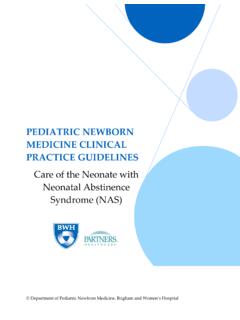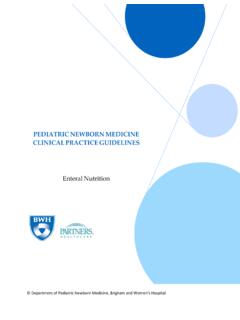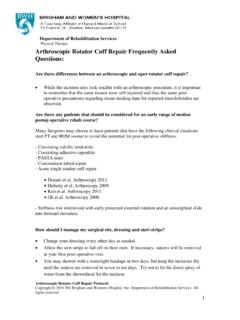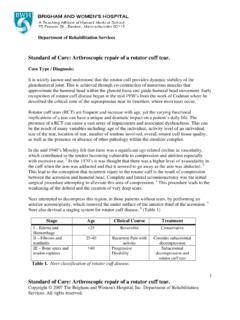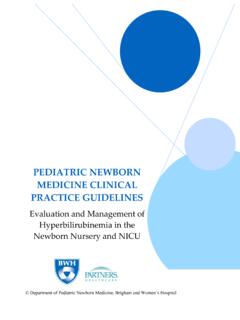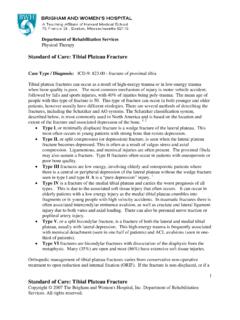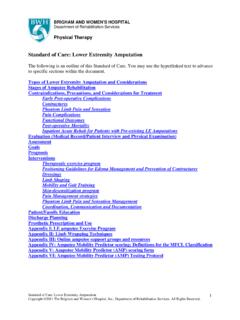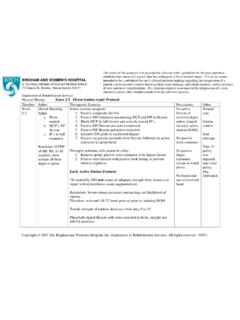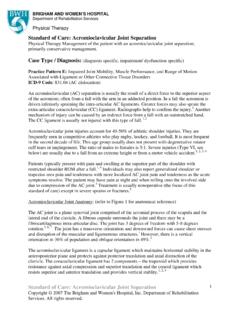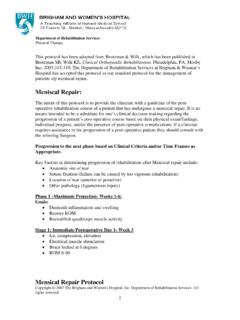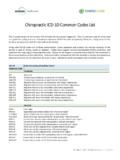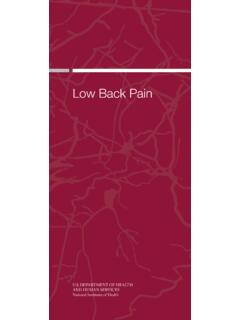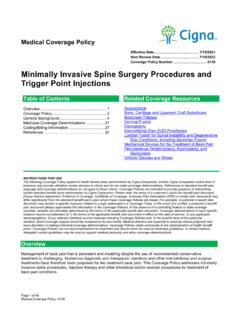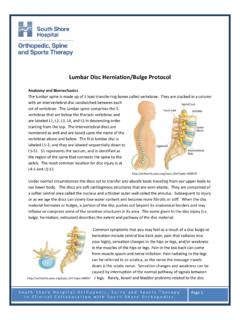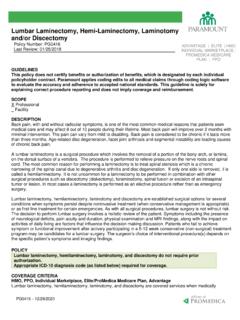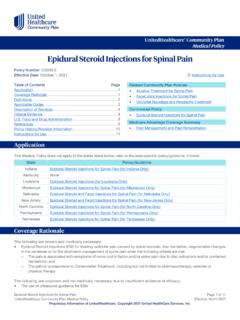Transcription of Standard of Care: Lumbar Spinal Stenosis /Physical Therapy ...
1 Standard of Care: Lumbar Spinal Stenosis / physical Therapy Management Copyright 2008 The Brigham and Women's Hospital, Inc. Department of Rehabilitation Services. All rights reserved. 1 Standard of Care: Lumbar Spinal Stenosis / physical Therapy Management Case Type / Diagnosis: Spinal Stenosis refers to a narrowing of the vertebral canal, intervertbral foramen, or both due to either osseous or soft tissue encroachment. Arnoldi et al. classified Lumbar Spinal Stenosis by etiology as either developmental/primary or degenerative/secondary. Primary Stenosis is caused by congenital malformations or defects in postnatal development and occurs rarely.
2 It can manifest itself in the 3rd or 4th decade of life. Degenerative Lumbar Stenosis occurs more frequently and is what is seen typically in the clinical setting. Degenerative Lumbar Stenosis usually manifests itself in the 6th or 7th decade of life, with slight preponderance in women1. It results from degenerative osseous or soft tissue changes, spondylolisthesis, postsurgical scarring, intervertebral disc herniation, or from combinations of these conditions. Other less frequent causes of secondary Stenosis are fractures, tumors, infection or systemic diseases such as Paget s disease.
3 Combinations of primary and secondary Stenosis can occur and are termed as mixed. Anatomically, Lumbar Spinal Stenosis can be classified as either central or lateral2. Central Stenosis involves narrowing of the Spinal canal around the thecal sac containing the cauda equina, and occurs as a result of the facet joint arthrosis and hypertrophy, thickening and bulging of the ligamentum flavum, bulging of the intervertebral disc , or spondylolisthesis. Stenosis at multiple levels is more common than strictly segmental Stenosis . In approximately 40% of cases, central Stenosis is caused by soft tissue Lateral Stenosis causes encroachment of the Spinal nerve in the lateral recess of the Spinal canal or in the intervertebral foramen, and results form facet joint hypertrophy, loss of disc height, intervertebral disc bulging, or spondylolisthesis.
4 Knowledge of the pathologic anatomy is important for correlating clinical signs and symptoms with imaging studies and treatment planning. Bony or soft tissue encroachment of an emerging nerve root may occur at any Lumbar level. The two lower motion segments (L3-4 and L4-5) are most commonly affected by degenerative Stenosis . NSAIDS are the medication of choice for decreasing inflammation, soft tissue swelling, and neural compression. The use of epidurals is questionable and tends to be more effective for patients with radicular pain symptoms due to herniated intervertebral discs rather than for Spinal Stenosis alone.
5 If a good response is achieved, a repeated injection is administered in 3-6 Computerized tomography, myelography and magnetic resonance imaging are the most important imaging studies for evaluating and quantifying the degree of forminal Stenosis and making the diagnosis. However, degenerative changes do not closely correlate with symptoms 1 Arbit,.E and Pannullo,S Lumbar Stenosis : A Clinical Review. Clin Ortho 384:137-143,2001 2 Arnoldi CC, Brodsky AE, Cauchoix J Lumbar Spinal Stenosis and nerve root encroachment syndromes: Definition and classification.
6 Clin Orthop 115:4-5,1976. 3 Ibid. 4 Spivak, JM Degenerative Lumbar Spinal Stenosis in JBJS, Vol 80, No. 7, July, 1998, p 1060. 5 Simotas, AC Nonoperative Treatment of Lumbar Spinal Stenosis . Clin Ortho 384, March, 2001,p155-156. 6 Sengupta DK, Herkowitz HN. Lumbar Spinal Stenosis - Treatment Strategies and Indications for Surgery Ortho Clin N Am 34(2003), p282. Department of Rehabilitation Services physical Therapy Standard of Care: Lumbar Spinal Stenosis / physical Therapy Management Copyright 2008 The Brigham and Women's Hospital, Inc.
7 Department of Rehabilitation Services. All rights reserved. 2 and abnormal findings occur in the asymptomatic population. 7 Arbit and Pannullo have summarized well the pathologic anatomy of central and lateral Stenosis including what to expect from particular imaging studies. Therapists treating patients who have Lumbar Spinal Stenosis are encouraged to review this reference to gain a more in depth understanding of the pathologic findings reported by imaging studies. Patients with Lumbar Spinal Stenosis who are symptomatic often relate a long history of low back pain, which is consistent with the slow nature of degenerative musculoskeltal changes.
8 Lower extremity pain, bilateral or unilateral, has been reported to occur in 80% of cases and back pain in 65%. Lower extremity pain symptoms are often distal (below knee) but can be proximal as well. Pain symptoms are often poorly localized and variable; symptoms are not likely symmetric when bilateral. Prolonged Spinal extension will intensify symptoms and often worsen lower extremity symptoms. Sensory changes occur frequently (51%) and are reported as numbness and/or paresthesias. Patients especially with lateral Stenosis may demonstrate radicular symptoms. Amundsen, et al reported ankle reflexes to be diminished or absent in up to 50% of patients with Lumbar Spinal Stenosis ; and, objective weakness to vary between 23% to 51%.
9 In patients with Lumbar Spinal Approximately 65% of patients with Lumbar Spinal Stenosis report neurogenic claudication , defined as poorly localized pain, paresthesias or cramping of one or both lower extremities which is brought on by walking and relieved by sitting or Very rarely will patients with Spinal Stenosis present with symptoms of cauda equina syndrome. Urinary dysfunction (urinary frequency, incontinence or episodes of frequent urinary tract infections) is not uncommon and has been reported in 10% of patients with advanced Spinal Stenosis Patients with Lumbar Stenosis will often demonstrate a worsening of complaints when position and posture is changed.
10 Symptoms worsen with Lumbar extension and with weight bearing; improve with sitting, standing with slight truck flexion, or lying down. Patients typically stand with a stooped posture or report that that they need to bend over in order to keep walking (using a shopping cart or walker). Walking uphill is easier than downhill. Anatomically, flexed postures widen the Spinal canal and foramen and reduce epidural pressure; thus are more relieving than extension posture/ positions. Extension of the Lumbar spine causes posterior protrusion of the intervertebral disc and bulging of the liagmenturm flavum.
